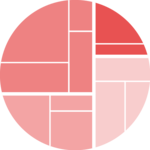Most basic pie chart
ggplot2 does not offer any specific geom to build
piecharts. The trick is the following:
-
input data frame has 2 columns: the group names (
grouphere) and its value (valuehere) -
build a stacked barchart with one bar only using the
geom_bar()function. - Make it circular with
coord_polar()
The result is far from optimal yet, keep reading for improvements.

# Load ggplot2
library(ggplot2)
# Create Data
data <- data.frame(
group=LETTERS[1:5],
value=c(13,7,9,21,2)
)
# Basic piechart
ggplot(data, aes(x="", y=value, fill=group)) +
geom_bar(stat="identity", width=1) +
coord_polar("y", start=0)Improve appearance
Previous version looks pretty bad. We need to:
- remove useless numeric labels
- remove grid and grey background
It’s better now, just need to add labels directly on chart.

# Load ggplot2
library(ggplot2)
# Create Data
data <- data.frame(
group=LETTERS[1:5],
value=c(13,7,9,21,2)
)
# Basic piechart
ggplot(data, aes(x="", y=value, fill=group)) +
geom_bar(stat="identity", width=1, color="white") +
coord_polar("y", start=0) +
theme_void() # remove background, grid, numeric labels
Adding labels with geom_text()
The tricky part is to compute the y position of labels using this
weird coord_polar transformation.

# Load ggplot2
library(ggplot2)
library(dplyr)
# Create Data
data <- data.frame(
group=LETTERS[1:5],
value=c(13,7,9,21,2)
)
# Compute the position of labels
data <- data %>%
arrange(desc(group)) %>%
mutate(prop = value / sum(data$value) *100) %>%
mutate(ypos = cumsum(prop)- 0.5*prop )
# Basic piechart
ggplot(data, aes(x="", y=prop, fill=group)) +
geom_bar(stat="identity", width=1, color="white") +
coord_polar("y", start=0) +
theme_void() +
theme(legend.position="none") +
geom_text(aes(y = ypos, label = group), color = "white", size=6) +
scale_fill_brewer(palette="Set1")




